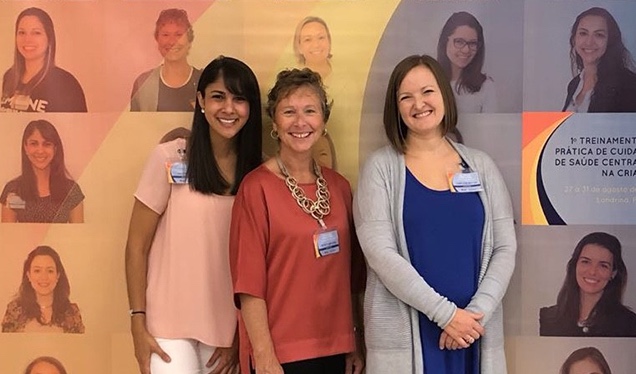

June 24, 2019
Carolina Fonseca, a volunteer at the Cancer Hospital of Londrina in Brazil, had been supporting children undergoing treatment there by purchasing art supplies and toys. Then, her cousin, Beatriz Kohler—a senior research nurse at Johns Hopkins for 25 years—suggested she talk to Patrice Brylske, director of child life at Johns Hopkins Children’s Center, to learn more about what could be done to improve children’s hospital experiences.
Fonseca visited and shadowed the Child Life department in 2017. Then she worked with the Londrina hospital to raise funds to bring Brylske and two child life specialists, Caroline Potter and Nilu Rahman, to the hospital the next year to provide training for staff. Brylske and Potter tag-teamed to teach a weeklong course—translated to Portuguese—for physicians, nurses, social workers and psychologists from the Londrina hospital and two others from Sao Paolo. Brylske and Potter provided skills-based education and a comprehensive approach to child-friendly health care practices. Meanwhile, Rahman conducted a series of two-hour workshops from the curriculum for more health care workers and students. Topics included procedural preparation and play; communication and patient-family-centered care; pain management; and death, dying and grief. Rahman also spent a day at the Londrina hospital rounding with a medical team and interacting with patients and their families.
One Londrina nurse said she and her colleagues had been struggling to support children while not being overwhelmed by stress. “She saw the information we were giving them as a way for nurses to feel inspired again, and it gave her ideas on how to help nurses feel happy about their work,” says Potter.
The experience built upon earlier international trainings Brylske and colleagues conducted, in Serbia in 2010 and Malaysia in 2016. Brylske says she has noticed similarities among health care workers regardless of their home country.
“They’re professionals, they are doing their best to care for patients and families, and they do not intend for treatments or procedures to frighten their patients,” she says. “It’s really transformational for them to learn there is a different way to provide patient- and child-centered health care.”
Brylske’s team has remained in contact with some of the Brazilian trainees, who have instituted changes like using treatment rooms instead of patient beds for potentially painful tasks such as blood draws, and having nurses wear colorful shirts rather than traditional white coats to help build rapport with patients.
The training provided “an incredible experience for me to see how lucky we are in our country to be able to provide child life services to patients and families, because it’s so needed,” adds Rahman. “I wish every country could have child life, because it meets psychosocial needs that other disciplines just don’t have the time, education or training to provide.”

